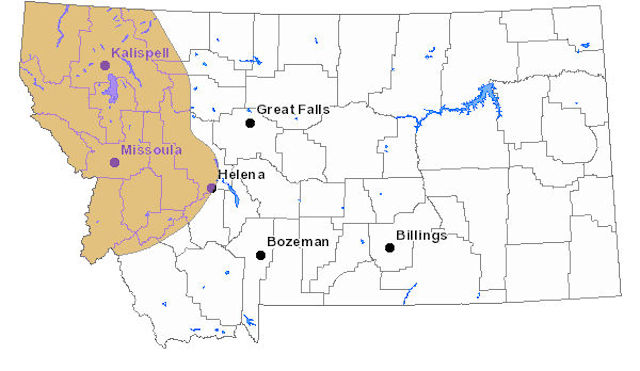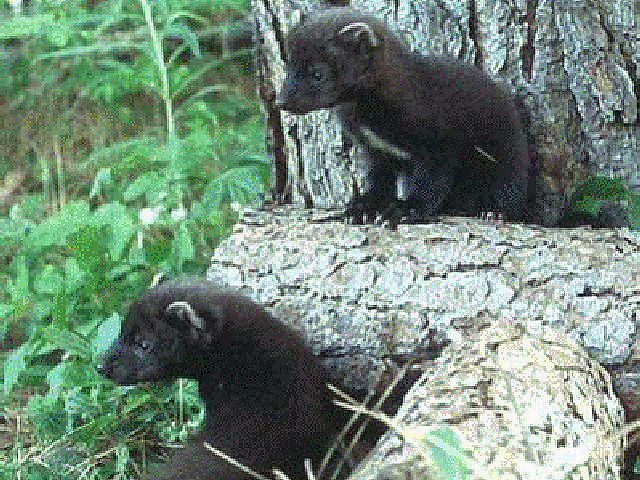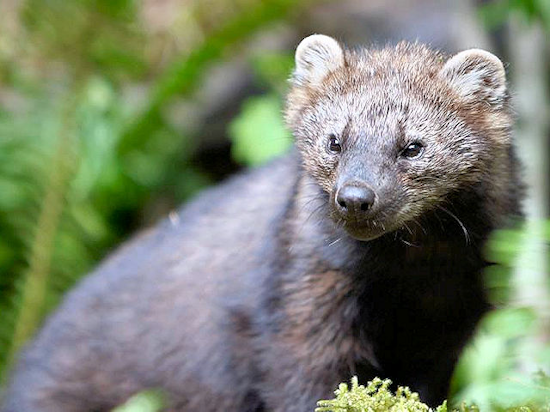Pointed face, rounded ears, short legs. Fur is usually black on tail, legs, and rump. Fur on head and shoulders may have a grizzled appearance resulting from tri-colored guard hairs. White patches are common around the genital area and in the axillae of the forelegs. Both males and females have paired scent glands which are used for scent-marking territories.
Total length: 23 to 40 inches. Weight: 3 to 12 pounds.
Habitat: Inhabits closed canopy, mature coniferous and deciduous forest. Availability of food is an important habitat component. Large deciduous trees are often used as maternal den sites.
Food Habits: Prey items are animals associated with the coniferous forest. Will also consume carrion and plant materials. Snowshoe hares, mice, squirrels, shrews, and birds are staple foods. Famous for ability to prey on porcupines.
Life History: Active during both day and night. Most hunting takes place on the ground. Most females breed for the first time at 12 months and produce their first litter at 24 months. Breeds during March and April. Produces one litter of about 3 young per year.
Similar Species: Marten - smaller, buffy patch on throat and breast. Wolverine - has yellowish stripes on sides and rump. Red fox - has a white tip on tail.
Fisher are woodland animals, and among the most effective predators on land. They are also the fastest American animal in trees. Females are less than half as big as males, yet command higher fur prices due to an extremely soft and silky fur. Also known in areas as fisher cat, black cat, tree fox or pekan, fisher have been known to follow trap lines, destroying the catches before the trapper arrives. Destruction of woodlands and high fur prices caused population declines up until the 1940's, but protection and reintroduction's have encouraged good fisher populations in many suitable habitat types.
 Description
Description
Fisher are usually dark brown in color.
Males oftentimes have a lighter grizzled
coloration on the face, head and over the
shoulders. The longer guard hairs in
the fur are 1 1/2 to 2 inches on the body
and 1/2 inch longer on the tail. The fur
on males is much coarser than on the females and
both are darkest on tail and legs. Two small,
white patches of fur are found in the front
armpit areas.
Males may measure 36 inches or longer and adult males often weight 10 to 12 pounds. Males rarely weigh more than 14 pounds. Females weigh about 1/3 of the average weight of males and most females are about the size of large mink, although their longer fur makes them appear to be larger. Typical females weigh between 4 and 5 pounds.
Fisher have 38 teeth, including four sharp canine teeth and flat topped molars to aid in chewing. Five toes register in fisher tracks and the inside toes are smaller and placed behind the other four. The fisher cannot retract it's claws and they are usually dulled somewhat by constant contact with the ground and rocks.
A pair of anal musk glands are present on both males and females and their musk is often released when the fisher is frightened or angry.
 Reproduction
Reproduction
Female fisher mate 6 to 8 days after giving
birth to their litters and delayed implantation
causes a gestation period averaging 352 days or
nearly a year. Breeding normally occurs
during late March or early April, and the
fertilized eggs do not become attached to
the female's uterus until the following January,
after which the growth of the litter begins.
One to four young are born in March or April and 2.7 is an average litter size. More females than males are usually born, contrary to most other furbearing species. The young are cared for strictly by the mother fisher and the natal den is usually in a hollow tree although a fisher will use an underground den if a better location is not available. Females usually breed when they are one year of age and males do not breed until they are two years of age.
Habits
Tracks in the snow are often the only sign
easily noticed when fisher are present in an
area, as the species is not usually observed in
the wild. Fisher are solitary animals
throughout most of the year, although snow
tracking often indicates that two or more
fishers will hunt in parallel patterns.
Activity is mostly at night, although it appears
that fishers hunt frequently during daylight
hours in wilderness habitats.
Male territories are larger than female territories and the sizes of these regularly patrolled areas vary according to the availability of prey species. A 10 square mile territory is typical for a female fisher and males commonly hunt a 30 square mile area. Circuits are irregularly patrolled although fishers travel pretty much in a straight line when they have determined to go to a certain location. Males usually pass through a given area in their territory about once every two weeks. Female circuits in winter usually vary from 3 days to a week.
Both male and female fisher are highly skilled predators and territory relocation are sometimes necessary as fishers are capable of overharvesting prey species. Fisher are aggressive hunters and competition with other furbearers is not only for the same prey species, but by direct contact. Raccoon may be killed by a large fisher in trees or on the ground. Fisher can also catch marten on the ground or in the trees, and usually there is either a good population of fisher or marten but not both. There is strong evidence to suggest that fisher kill significant numbers of bobcat kittens too. Mother bobcats must leave their kittens unattended to hunt and there is no safe place in which to hide a bobcat den from a hunting fisher.
Snowshoe hares are a preferred food and a main reason that fisher like to frequent the dense cedar swamps. With keen senses of sight and smell, fisher often stalk the snowshoe rabbits, but they will trail them as well by scent alone. Red squirrel are a common prey species and fisher also eat mice, rats, voles, and shrews, which are avoided by most predators due to a musky odor. Grouse and ptarmigan are eaten regularly and there are records of fisher killing fox, mink and otters.
Fisher are skilled at killing porcupines. Attacks are to the face of the porcupine as the fisher circles and circles the porcupine who attempts to keep it's back toward the fisher. After repeated attacks to the quill free facial area, the porcupine becomes vulnerable to a throat attack. Porcupine are not safe when climbing trees, as fishers simply attack them from top side. Porcupines may be safe from fisher attacks when they are on branches and facing away from the fisher, or when they are in a position to hide their faces in a crevice or hole. Fisher often clean these skins as clean as if they had been skinned by a man. Fisher droppings often include quills, which seem to pass through the digestive system without ill effects.
Uneaten foods are usually cached for later use by fishers and the species will sometimes deposit their musk on the uneaten portions to discourage other animals. Fisher also eat carrion and substantial amounts of wild berries in season.
General
It was once thought that fisher required mature
forests, but the species can thrive in newer
second growth forest, favoring large tracts of
pine, spruce, aspen, birch and cedar swamps.
Good populations are considered to be one fisher
per 10 square miles. As the only
consistent predator of porcupines, fisher
provide a service by controlling this species,
as well as the damage that the porcupines
inflict upon forests.
Fisher contribute to the overall health of prey species when their densities are light or moderate. Dense populations of fisher create problems for a variety of other species, including other furbearers. Fisher do have to abandon territories as food sources become depleted and less mobile furbearers can become malnourished when competing for the same prey species as fisher.
Predation upon fisher by other predators is not thought to be serious. A lynx or bobcat will rarely kill a fisher and wolves have been known to kill fisher caught out on frozen lakes. Young fisher are killed at times by large owls, eagles and coyotes. The solitary nature and infrequent use of the same dens keeps fisher free of most diseases and parasites. Mange can occur and fisher are also vulnerable to distemper, fleas, tapeworms and nematodes.
Ten years of age is considered old in a fisher.




